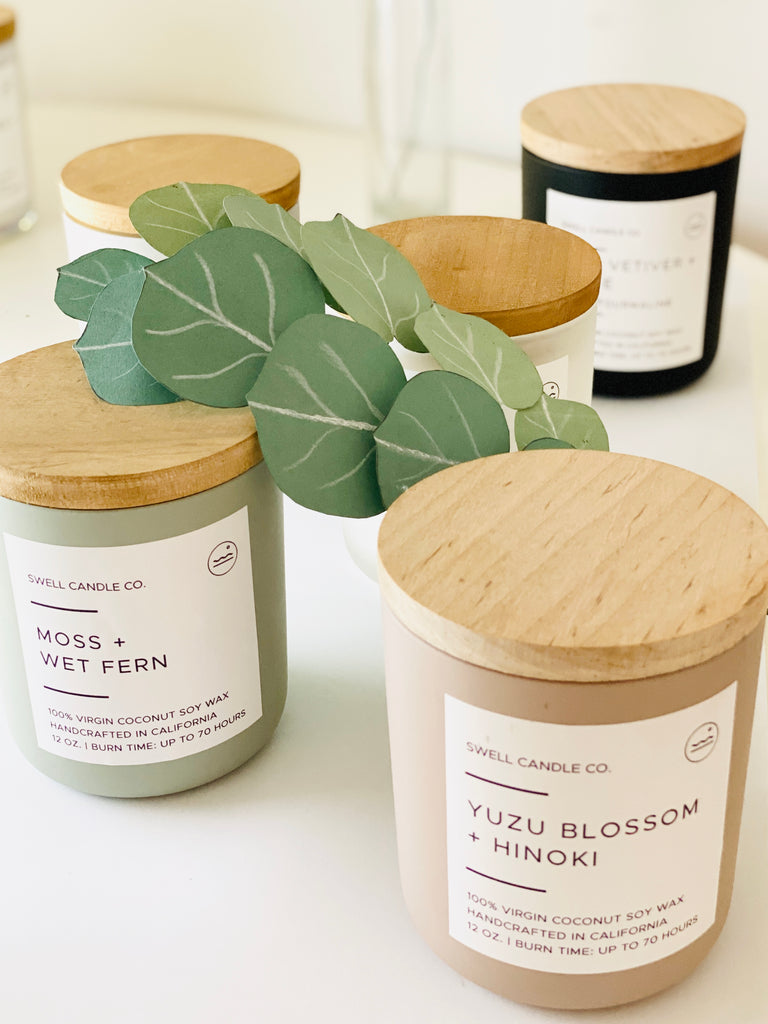1. You may have been burning your precious candles incorrectly all this time. The first time you light a candle, you should let it burn long enough so that the whole top layer of wax becomes liquid, which could take several hours depending on the size of the candle.
Not doing this might cause the candle to burn unevenly and tunnel (when only the wax near the wick melts and leaves a ring of hard wax on the outer edges).
2. If your candle has started tunnelling, you can still salvage it!
Cover the top of your jar candle with foil, then cut a hole in the centre where the wick/flame will be. This encourage the hard outer wax to soften and melt evenly. Be sure to let the candle burn for several hours with the foil lid to ensure the whole top layer is liquid.
3. A candle shouldn't produce smoke when it's burning.
If it is smoking, maybe it's been hanging out with the wrong crowd and you should talk to it about its priorities in life. More likely, though, the wick is too long. Put the flame out, wait for the wick to cool and trim it to about a quarter of an inch (about 6mm) in length.
4. Freezing a candle won't actually make it last longer.
There are a lot of rumours that say freezing a candle before lighting it will make it last longer. However, according to the National Candle Association, though it may initially burn slower than a room temperature candle, this effect will not last long as the candle returns to room temperature.
Additionally, others claim that freezing the wax cracks it and damages the candle.
So, whatever few extra minutes you might gain from freezing your candle, it's probably not worth it.
5. You should never blow out a candle.
Blowing out a candle produces lots of soot and smoke, and you also risk blowing droplets of hot liquid wax in the surrounding area, which might land on the furniture or someone's eyeball. Instead, according to the European Candle Association, the best way to put out a candle is to use a candle snuffer, which puts the flame out by depriving it of oxygen. Or, you can use something inflammable to dip the wick into the wet wax and immediately straighten it again. The wax will protect the wick from crumbling when it's cool again.
6. Not all candles drip.
There are two ways in which candles are made to be dripless. It could be that the candle has a thicker wick which absorbs the liquid wax. Another way involves making a thin candle from soft wax, then dipping it into a thicker wax that burns at a higher temperature (therefore more slowly). When the wick is lit the inner core of soft wax melts quicker and is contained by the harder outer edge. Also, beeswax candles are naturally dripless.
However, even these candles can drip if they're near a draft or if the wick is too long. If you want gothic drippy candles, because that is what's most in line with your aesthetic, your best bet is to look for candles that have very thin wicks or are specialist dripping candles.
7. Candles have been made out of cows, insects, and whales.
Tallow (a byproduct of beef fat rendering) was popular in Europe in the Middle Ages, but candles have also been made out of wax gathered from insects and moulded with seeds, spermaceti from sperm whales, beeswax, and various different plants. Candles are now mostly made from paraffin (a solid extracted from crude oil), beeswax or soy.
8. They have also been made using fish. Like, actual whole fish.
Specifically the candlefish, or Eulachon. It has such a high fat content that it can be used as a candle whole.
9. A candle flame doesn't always point up.
Under normal conditions, a candle light always points up because the flame warms nearby air, which rises up and is replaced by cooler air. This constant cycle (the convection current) creates the teardrop shape of a candle flame.
Under microgravity, (i.e. on a space station) NASA scientists revealed that a flame will be spherical. This is because there is no gravity, therefore the heavier, colder gases would not be pulled down and no convection current would be created.
10. A candlemaker or seller is known as a chandler.
It derives from the Old French word "chandelier", which, before the advent of electricity, was a ceiling fitting made of several candles.
11. Scented candles and dinner are only a good combination if you know what you're doing.
The flavours we experience when eating food are the combination of our sense of taste and our sense of smell. So, naturally, scented candles at the dinner table will have an impact on the taste of the food.
However, the aptly named Chandler Burr, created a fine dining experience using fragrances to compliment the gourmet food for a ~unique culinary experience~.
12. Putting candles on cakes is a tradition that dates back to Ancient Greece.
Ancient Greeks would bring a cake decorated with candles so that it represented the glowing moon, to the temple of Artemis, the Goddess of the hunt and the moon.
This didn't become a birthday tradition until the 1700s when Kinderfesten became common. This was a birthday celebration for children, when a candle on a cake was used to represent every passing year, basically just like we do now.


Leave a comment